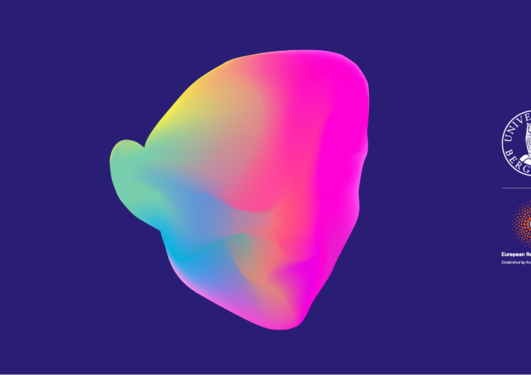AI, maskinsyn og kunst
Hva skjer med blikket når det blir automatisert? Kan vi forstå AI-basert maskinsyn som kuratert av mennesker? Nicolas Malevé og Audrey Samson er kunstnere og kunstforskere med AI som spesialfelt, som er i Bergen i forbindelse med Machine Vision-prosjektet.

Hovedinnhold
The workshop, to be held in the Digital Lab in the basement of the Humanities Library, will include three talks followed by discussion. All are welcome to attend.
Jill Walker Rettberg: About the Machine Vision Project
Jill Walker Rettberg will give a brief overview of research in the project Machine Vision in Everyday Life.
Audrey Samson: The Automated Gaze
Audrey Samson (Goldsmiths) will discuss ongoing research into the gaze and its automation to consider how perspective actively inscribes by marking bodies and etching the earth.
Nicolas Malevé: The exhibitionary complex of machine vision
Nicolas Malevé (Aarhus University) proposes that understanding AI-driven machine vision as curated by humans allows us to identify the critical assemblages that enable interventions.
Extended abstract for Malevé's talk: The methods and functions we tend to associate with the visual arts are operating in the underlying infrastructure of digital platforms. Machines become slowly able to emulate human curation or reframe artistic creation because software itself is increasingly a product of curation. Technology is able to unsettle art practices and institutions because it is itself deeply informed by the very practices it attempts to emulate and surpass.
Computer vision offers a canonical example of how curation is operationalised in the production of seeing agents and machine interpretation of visual content. The creation of datasets, the collections of images used to train algorithms, are a case in point. More than mathematics, the frenetic acquisition of image collections aimed at rendering the visual world algorithmically tractable have provoked a qualitative jump in machine vision (Deng et al., 2010). Curation, image interpretation, aesthetics have become epistemic problems for computer scientists. Methods that traditionally pertained to art historians, curators or artists are mobilised to produce technological knowledge. And this knowledge in turn powers the platforms that reshape the art institution.
A series of recent controversies highlight the tensions occurring when computer vision import methods of curation and interpretation of images. The dataset and image classification work performed by computer vision scientists become sites of intervention for hybrid practitioners. The richness of the controversies can be measured by the changes they provoked in the development of datasets as well as their impact on a non-specialist audience. But their importance exceeds a debate over ideas. A controversy tests the extensive assemblages of institutions, forums, modes of communication, publics as well as theories at play (Latour, 2007). As a controversy heats up, it reveals an underlying crisis that traverses the academy, the art institution or the disciplinary distribution of collectives of artists and scientists, as well as the economy of the artist studio or the lab. As such a study of controversies provides valuable material to study the complexity of the artist role in inducing societal change and the network of operation it involves.
Examples of controversies include Trevor Paglen and Kate Crawford's (2019) work on ImageNet, Joy Buolamwini's artwork on facial recognition and race (Buolamwini and Gebru, 2018), Andrew Harvey's MegaPixels (2017) or more recently debates about the reappropriation of creative content in text-to-image software such as Dall-e or Stable Diffusion. By different means, artists address the methods involved in processes of selection and classification of images of computer vision and their politics. This talk concentrates on the exhibitionary complex (Bennett, 2013) formed by the production of machine vision datasets and the artistic interventions that respond to them. Through an engagement with machine vision's cultural techniques, artists and hybrid practitioners expose the relations of computer scientists to images. They also connect different sites where images are exhibited and various kinds of viewers are enacted: photo-sharing websites, cognitive psychology labs, the Amazon Mechanical Turk platform, private and public art institutions, Ted talks and social media. Triggering heated exchanges, their work also provokes an unexpected answer from the scientific communities: exhibition reviews and art criticism.
Mapping these controversies will help me articulate the following questions: What are the critical assemblages that allow for interventions in machine vision in general and in the curation of datasets in particular? Which kind of alliances and attachments are created? What is their potential and their limits?
References
Bennett, T. (2013) The Birth of the Museum: History, Theory, Politics, The Birth of the Museum, Culture: Policy and Politics. Taylor and Francis.
Buolamwini, J. and Gebru, T. (2018) Gender Shades: Intersectional Accuracy Disparities in Commercial Gender Classification, in: Friedler, S. A. and Wilson, C. (eds.) Proceedings of the 1st Conference on Fairness, Accountability and Transparency. New York, NY, USA: PMLR,81, pp. 77–91.
Crawford, K. and Paglen, T. (2019) Excavating AI , The Politics of Images in Machine Learning Training Sets. Available from: https://www.excavating.ai/ [Accessed 19 March 2020].
Deng, J., Berg, A., Li, K. and Li, F. F. (2010) What Does Classifying More Than 10, 000 Image Categories Tell Us?, in: ECCV.5, pp. 71–84.
Harvey, A. (2017) MegaPixels. Available from: https://ahprojects.com/megapixels-glassroom/ [Accessed 30 March 2022].
Latour, B. (2007) Reassembling the social. An introduction to Actor-Network-Theory. New York, NY, US: Oxford University Press.
